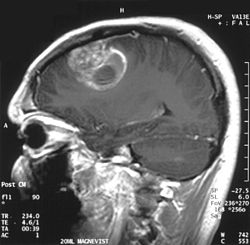Glioblastoma multiforme
Glioblastoma multiforme is a malignant brain tumor that carries an extremely poor prognosis.
Signs and symptoms
- Symptoms of increased Intracranial pressure including headache, pappiledema, nausea or vomiting, and diplopia.
Treatment
Currently, most patients with Glioblastoma multiforme are initially treated with maximal surgical removal of the tumor, which is then followed by radiotherapy and Chemotherapy, most often with Temozolomide, a chemotheraputic agent that has been shown to have activity against glioblastoma multiforme. Radiosurgery is being investigated in the treatmet glioblastoma multiforme.
Glioblastoma Multiforme Media
Sagittal MRI with contrast of a glioblastoma WHO grade 4 in a 15-year-old boy
Radiation treatment planning for glioblastoma. GTV: gross tumor volume, CTV: clinical target volume, PTV: planning target volume.
Histopathology of glioblastoma, showing high grade astrocytoma features of marked nuclear pleomorphism, multiple mitoses (one at white arrow) and multinucleated cells (one at black arrow), with cells having a patternless arrangement in a pink fibrillary background on H&E stain.
Lower magnification histopathology, showing necrosis surrounded by pseudopalisades of tumor cells, conferring a diagnosis of glioblastoma rather than anaplastic astrocytoma







